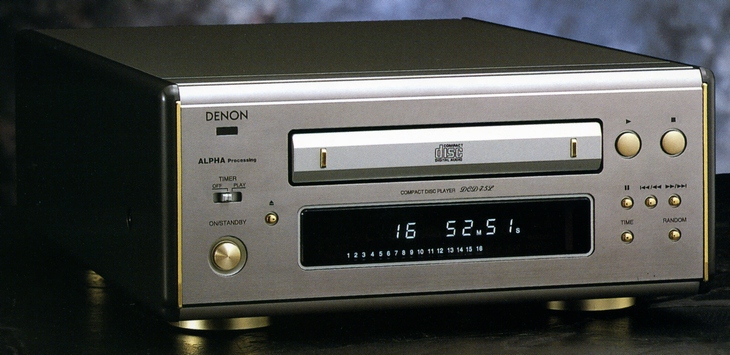
DENON DCD-7.5L
¥ 55,000 (around 1999)
Commentary
A CD player with an alpha processor.
Equipped with DENON's own ALPHA processor.
The ALPHA processor is an analog waveform reproduction technology that reproduces 16-bit data at 20-bit quality. Using digital data recorded on CDs and other media as a key, it interpolates digital data so that the sound becomes closer to the analog waveform that should have existed in the natural world. This makes it closer to a smooth analog waveform and improves the ability to express fine nuances such as the moment when the afterglow disappears.
In addition, the quantization distortion, which was the fate of digital systems, has been greatly reduced.
The D/A conversion method is equipped with real 20-bit Λ (Lambda) S. L. C.
Lambda stands for Ladder-form Multiple Bias D/A, a new method. Using a newly developed LSI, digital data is divided into two systems, each of which is shifted by applying digital bias in the + and - directions near the 0 cross point, thereby eliminating 0 cross distortion in principle.
When the digital data to be played back is smaller than this shift amount, such as when the volume is low, no 0 cross distortion occurs because there is no value crossing the original 0 cross point. Then, the two shifted data are D/A converted and added together to remove the direct current component, and an analog output with no 0 cross distortion is obtained. These two data have no MSB inversion and no 0 cross distortion in the synthesized waveform. The average of the two signals reduces any bit, the distortion is reduced to 1/2 by averaging the two signals.
If the reproduced digital data is at a level larger than the shift amount, distortion may occur because it crosses the original 0 cross point, but this can be eliminated by the S. L. C. MSB correction.
At momentary peak levels (more than about 99.6% of the maximum level), which are absent or present only a few times in a song, the lambda stops the shift operation, thereby maximizing the converter's dynamic range and ensuring a wide dynamic range.
In addition, the 20 bit 8-times over-sampling signal produced by a digital filter is converted into an analog signal at high speed by using a real 20 bit configuration, and the dynamic range is greatly improved. Unlike the dynamic bit shift method using an attenuator or switching circuit, the dynamic bit shift method has no nonlinear distortion factor and is stable.
The D/A converter eliminates the time difference between the left and right stereo signals by using the left and right independent D/A converter method.
The digital filter is equipped with an 8 x oversampling digital filter.
Equipped with an optical digital output terminal.
It is equipped with performance functions such as random play, 20-track program and repeat between A and B.
In combination with the PR ESTA 7.5L/6.5L series, system functions such as synchronized recording, timer playback, auto function and auto power on can be performed.
Wireless remote control is included.
Model Rating
| Type | CD Player |
| D/A conversion part system | Real 20-bit Lambda Super Linear Converter |
| Filter | 20-bit 8 x oversampling digital filter |
| Frequency characteristic | 2 Hz to 20 kHz |
| Signal-to-noise ratio | 108dB |
| Dynamic range | 97dB |
| Total harmonic distortion factor | Not more than 0.0025% |
| Channel separation | 100dB |
| Analog output voltage | 2.0V/10k Ω |
| Pwer | 100 VAC, 50Hz/60Hz |
| Power consumption | 10W Approximately 4W (during standby) |
| External dimensions | Width 250x Height 112x Depth 350 mm |
| Weight | 3.6kg |
| Attachment | Wireless Remote Control |
.jpg)
.jpg)